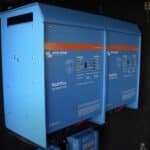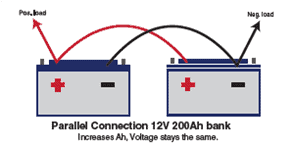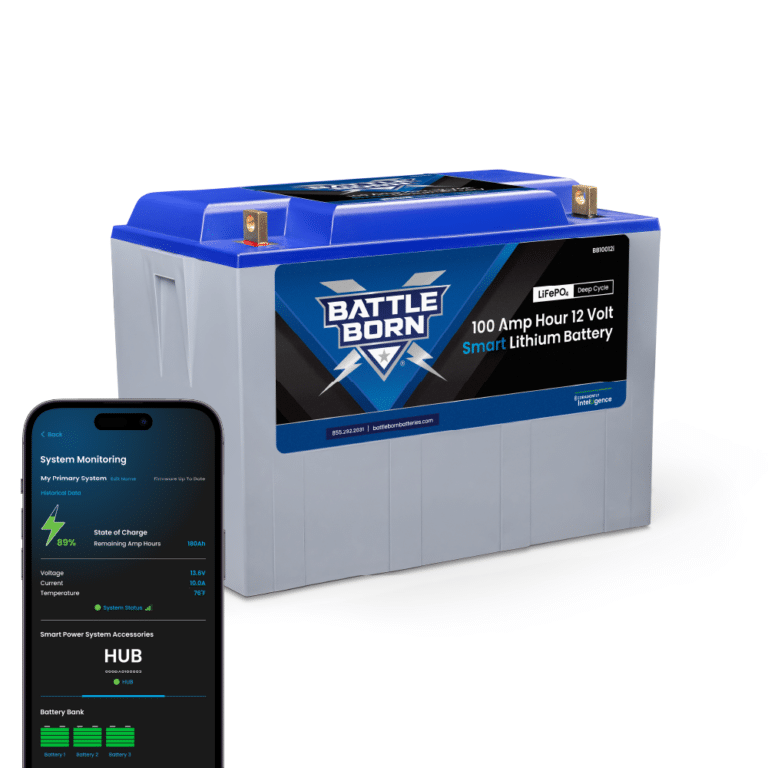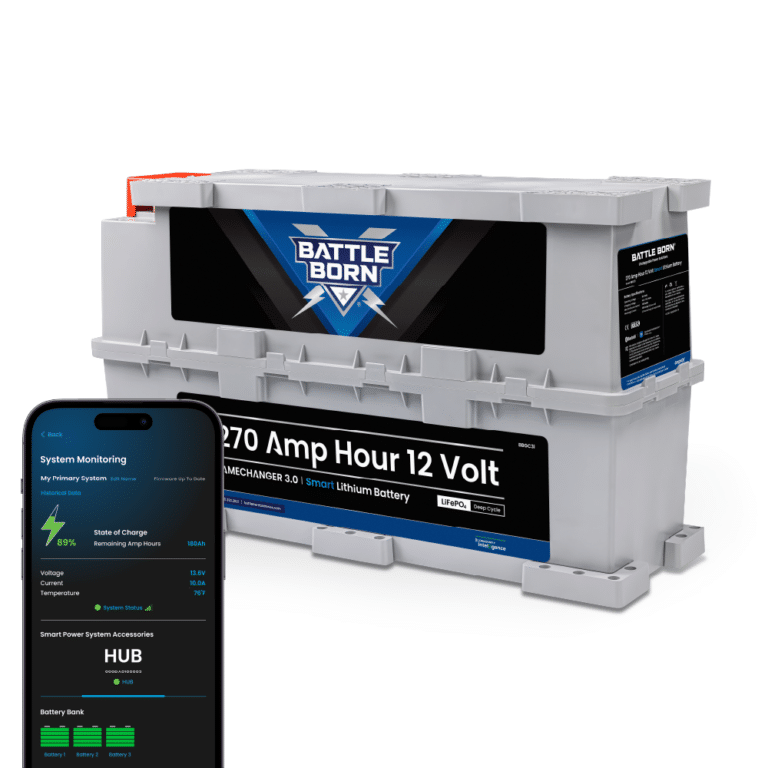
MENUMENU
TALK TO AN EXPERT
Special Hours: 7AM – 6PM PST
TALK TO AN EXPERT
Special Hours: 7AM – 6PM PST
Here at Battle Born Batteries, we believe in the power of lithium-ion battery technology. Its cutting-edge performance capabilities will have your system running at its full potential for years to come! In the latest of our FAQ series, we break down the technology as our CEO Denis highlights the basics of lithium batteries for beginners.
What do you need to know about lithium batteries so you can determine which option is the best for your system? We have plenty of choices when it comes to batteries, so knowing what you’re powering, where you want to take it and its size requirements will be most helpful when buying batteries. If you let us know the dimensions of the space you’re working with, along with the inverter type and DC load, our sales and tech team can help you choose the best LiFePO4 battery. Our batteries are rated for a 100 amp hour series, a 200 amp hour surge for 30 seconds and half a second for higher surges.
You may often hear us talk about battery cycles, and how our lithium batteries can complete anywhere between 3,000 to 5,000 cycles in its lifespan. A battery cycle is defined as the time it takes for the battery to reach a 0% state of charge and then go back up to 100% fully charged. Our batteries can last more than 5,000 partial cycles if they aren’t completely drained at a constant rate. For the most accurate way to measure battery life, we recommend determining the total amp hours used in the system.
Inside our lithium batteries is a Battery Management System, or BMS. It protects the battery from high and low voltages, temperatures, and short circuits. It shuts off the battery to help protect the lithium-ion cells so they can become virtually maintenance-free for the consumer. To keep the battery at optimal operations, the BMS will passively balance the cells when the battery is at the top of the charge cycle occurring between 14.2V and 14.6V.
As stated in this new video, we stand by the fact that our batteries have the best short circuit protection in the industry! They work this well because we use cylindrical cells in our batteries which can be drawn down 100%.
If a battery can’t be drawn below 80%, it most likely contains prismatic pouch cells, which can lead to a shorter lifespan of about 900 cycles if continuously discharged.
Voltage is the amount of energy between two points in a circuit, and the state of charge (SOC) is the percentage of a battery’s charge. Voltage and the SOC are important to understand when switching to lithium.
The state of charge does not vary with voltage in a lithium-ion battery in the way it does with lead acid. If you look at a lead acid battery, the voltage will decrease almost linearly as the SOC decreases. A lithium-ion battery behaves very differently: although there is some decrease, the middle of the discharge curve is almost flat. It decreases a little bit but not as much as a lead acid battery.
If you’re trying to measure the state of charge from the voltage of the battery, you’ll find that it isn’t always very easy to interpret. The best way to measure the state of charge is with a shunt, which monitors amps going in and coming out of a battery and translates it into amp hours used. Please note that shunts are included with most battery monitor kits.
When it comes to the proper charging voltages for systems, please note that our team recommends aiming for 14.4V to provide a full charge on the battery and allow for proper cell balancing, but any number between 14.2 and 14.6 is acceptable.
The depth of discharge indicates how much of the battery has been discharged from it at a particular point in time. Considered to be the complement of the SOC, it will not shorten the battery’s lifespan. Our LiFePO4 battery technology allows for it to be discharged in full, thousands of times.
What’s the difference between the two?
In parallel, batteries will increase in amp–hours while series will increase in voltage. Connection-wise, parallel is positive to positive in a system and series is positive to negative.
If you plan to wire your lithium batteries in series, please let us know when you place your order so we can make sure to match the capacity. In some instances, with larger battery banks, it’s common to see series and parallel connections in the system. Check out the diagram below for an example of each connection:

We designed our lithium batteries to give you every drop of energy possible with the technology contained inside it. That’s why they work so well as drop-in replacements for lead-acid. At the same size as a group 27 and group 31 battery, it can easily be accommodated anywhere the rest of your system is located. Whether it’s a battery box or rack, our drop-in replacements have your back!
Battle Born Batteries also work well with about 99 percent of the components that AGM battery systems often use. However, it doesn’t hurt to give us a call just so we can double–check that the components are truly compatible.
With a battery monitor, you can easily see specific information about how much power you have left and how many amp hours have been consumed. It also calculates the remaining battery capacity based on amp-hour consumption, discharge current, voltage and power consumption in watts. In our store, we offer the Victron BMV-700, BMV-702 and BMV-712. With Bluetooth technology, the programming can allow you to monitor your system on a smartphone, tablet, or other device.
One component our sales and tech team often recommend having is a multimeter. While we do not offer these in our store, multimeter devices measure voltage, resistance, and currents. In this FAQ video, Denis demonstrates how a fluke multimeter can accurately measure your batteries’ output while offering AC/DC voltage options. Our team often uses multimeters when troubleshooting issues with systems, so it can be an important tool for you to utilize in your system.
Another important component for your system can be a Battery Isolation Manager or a DC/DC charger. They are two different devices doing similar tasks, but it depends on your system:
–A BIM acts as a relay when turned on because it makes your starter battery parallel with house batteries. It allows the alternator to recharge the house bank, especially after a large load. It follows an internal algorithm to charge the house bank, so you don’t overheat your system’s alternator on a long drive.
–An isolated DC/DC charger is basically a converter that takes power from the starting battery and delivers it to the house battery. Note that house batteries need to be deep cycle batteries designed to provide a steady amount of current over a long period of time. It charges and regulates at 30 amps, which is important to keep in mind while connecting different loads to the system.
You can buy the battery isolation manager or a battery to battery/ DC to DC charger over at our store.
Automatic charge relays are also important for lithium batteries. An ACR connects a starter battery to a house bank in case the bank needs to be charged from the battery, or vice versa. When using an AGM or lead-acid starter battery with a lithium battery bank, an ACR will not work because of differences in cutoff voltages. With a higher cutoff for lithium and the potential for one battery to fall too low while connected, lithium battery banks will keep it at a higher voltage and never be disconnected.
Questions, comments, or concerns about your lithium batteries? There’s plenty of online resources, such as other installments of our new FAQ series and the FAQ section on our website. Still in need of assistance, even after checking out our YouTube channel as well? Our tech team is ready to help! Give us a call at 855-292-2831 or send us an email at [email protected].
Shop Best Sellers








Ask a technical specialist now at 855.292.2831
Stay in the Know
6 thoughts on “Lithium Batteries for Beginners: The Basics”
New to Lithium charging needs. Off the grid, if at day 1 after sundown, batteries are 70%, should I run my generator to get them back to 100%, or will that 70% which may be 60% in the morning be ok for the batteries long term? Just trying to get a handle on what state of discharge is harmful long term, should I wait until they get to the 80% discharge before running power to recharge them ( planning on 300W panel, which may be partially shaded much of the day) and the best plan for the Battleborns life. Also planning on running a 200Ah bank with the Solarflex system I ordered factory installed. Great video’s and love American made, sorry if you already covered this and I missed the information.
Hi Allan, thanks for reaching out. We have plenty of charging resources at the link to our Youtube channel here https://www.youtube.com/playlist?list=PLEWN3AEgk3Ly2ToECmpU3LGRQFq6eXxo3
We’re glad to hear you’re a fan of our products as well! Please let us know if you have any additional questions and have a great rest of your afternoon.
I have a 2 going on 3 year battleborn can 1 had another new one to the existing one
Hi Michael, you can add new batteries to your original Battle Born bank up to two years down the road without damaging, reducing lifespan, or harming them in any way. Please check out our FAQ page here https://battlebornbatteries.com/faq/ and thank you very much for being a fan of our products!
Do repeated shallow discharges and recharges to 100% harm a battleborn battery?
Great question David, the answer is no. Shallow discharges and recharges will not harm or diminish the life of a battery. If you have more questions feel free to give one of our sales technicians a call at (855) 292-2831 or email us at [email protected].